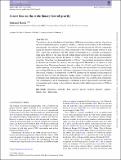Files in this item
A new line on the wide binary test of gravity
Item metadata
| dc.contributor.author | Banik, Indranil | |
| dc.date.accessioned | 2021-10-13T14:30:10Z | |
| dc.date.available | 2021-10-13T14:30:10Z | |
| dc.date.issued | 2019-08 | |
| dc.identifier | 276206307 | |
| dc.identifier | f9041a4b-a0c3-480e-9571-418298338122 | |
| dc.identifier | 85070093129 | |
| dc.identifier.citation | Banik , I 2019 , ' A new line on the wide binary test of gravity ' , Monthly Notices of the Royal Astronomical Society , vol. 487 , no. 4 , pp. 5291-5303 . https://doi.org/10.1093/mnras/stz1551 | en |
| dc.identifier.issn | 0035-8711 | |
| dc.identifier.other | ORCID: /0000-0002-4123-7325/work/101218052 | |
| dc.identifier.uri | https://hdl.handle.net/10023/24132 | |
| dc.description | Funding Information: IB is supported by an Alexander von Humboldt postdoctoral fellowship. | en |
| dc.description.abstract | The relative velocity distribution of wide binary (WB) stars is sensitive to the law of gravity at the low accelerations typical of galactic outskirts. I consider the feasibility of this wide binary test using the 'line velocity' method. This involves considering only the velocity components along the direction within the sky plane orthogonal to the systemic proper motion of each WB. I apply this technique to the WB sample of Hernandez et al., carefully accounting for large-angle effects at one order beyond leading. Based on Monte Carlo trials, the uncertainty in the one-dimensional velocity dispersion is ≈100 m s-1 when using sky-projected relative velocities. Using line velocities reduces this to ≈30 m s-1 because these are much less affected by distance uncertainties. My analysis does not support the Hernandez et al. claim of a clear departure from Newtonian dynamics beyond a radius of ≈10 kAU, partly because I use 2σ outlier rejection to clean their sample first. None the less, the uncertainties are small enough that existing WB data are nearly sufficient to distinguish Newtonian dynamics from Modified Newtonian Dynamics. I estimate that ≈1000 WB systems will be required for this purpose if using only line velocities. In addition to a larger sample, it will also be important to control for systematics like undetected companions and moving groups. This could be done statistically. The contamination can be minimized by considering a narrow theoretically motivated range of parameters and focusing on how different theories predict different proportions of WBs in this region. | |
| dc.format.extent | 13 | |
| dc.format.extent | 948650 | |
| dc.language.iso | eng | |
| dc.relation.ispartof | Monthly Notices of the Royal Astronomical Society | en |
| dc.subject | Binaries: general | en |
| dc.subject | Dark matter | en |
| dc.subject | Galaxy: disc | en |
| dc.subject | Gravitation | en |
| dc.subject | Methods: data analysis | en |
| dc.subject | Proper motions | en |
| dc.subject | QC Physics | en |
| dc.subject | QB Astronomy | en |
| dc.subject | Space and Planetary Science | en |
| dc.subject | Astronomy and Astrophysics | en |
| dc.subject | NDAS | en |
| dc.subject.lcc | QC | en |
| dc.subject.lcc | QB | en |
| dc.title | A new line on the wide binary test of gravity | en |
| dc.type | Journal article | en |
| dc.contributor.institution | University of St Andrews. School of Physics and Astronomy | en |
| dc.identifier.doi | 10.1093/mnras/stz1551 | |
| dc.description.status | Peer reviewed | en |
| dc.identifier.url | https://arxiv.org/abs/1902.01857 | en |
This item appears in the following Collection(s)
Items in the St Andrews Research Repository are protected by copyright, with all rights reserved, unless otherwise indicated.

